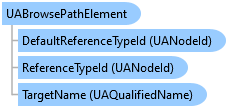

OPC Studio User's Guide and Reference
UABrowsePathElement Class


'Declaration<CLSCompliantAttribute(True)> <ComDefaultInterfaceAttribute(OpcLabs.EasyOpc.UA.Navigation.ComTypes._UABrowsePathElement)> <ComVisibleAttribute(True)> <GuidAttribute("3CE3E988-805D-42AF-AC15-974D93E91240")> <TypeConverterAttribute(OpcLabs.EasyOpc.UA.Navigation.Implementation.UABrowsePathElementConverter)> <ValueControlAttribute("OpcLabs.BaseLib.Forms.Common.ObjectSerializationControl, OpcLabs.BaseLibForms, Version=5.82.174.1, Culture=neutral, PublicKeyToken=6faddca41dacb409", DefaultReadWrite=False, Export=True, PageId=10001)> <SerializableAttribute()> Public NotInheritable Class UABrowsePathElement Inherits OpcLabs.BaseLib.Info Implements LINQPad.ICustomMemberProvider, OpcLabs.BaseLib.ComTypes._Info, OpcLabs.BaseLib.ComTypes._Object2, OpcLabs.EasyOpc.UA.Navigation.ComTypes._UABrowsePathElement, IUABrowsePathElement, System.ICloneable, System.Runtime.Serialization.ISerializable, System.Xml.Serialization.IXmlSerializable
'UsageDim instance As UABrowsePathElement
[CLSCompliant(true)] [ComDefaultInterface(OpcLabs.EasyOpc.UA.Navigation.ComTypes._UABrowsePathElement)] [ComVisible(true)] [Guid("3CE3E988-805D-42AF-AC15-974D93E91240")] [TypeConverter(OpcLabs.EasyOpc.UA.Navigation.Implementation.UABrowsePathElementConverter)] [ValueControl("OpcLabs.BaseLib.Forms.Common.ObjectSerializationControl, OpcLabs.BaseLibForms, Version=5.82.174.1, Culture=neutral, PublicKeyToken=6faddca41dacb409", DefaultReadWrite=false, Export=true, PageId=10001)] [Serializable()] public sealed class UABrowsePathElement : OpcLabs.BaseLib.Info, LINQPad.ICustomMemberProvider, OpcLabs.BaseLib.ComTypes._Info, OpcLabs.BaseLib.ComTypes._Object2, OpcLabs.EasyOpc.UA.Navigation.ComTypes._UABrowsePathElement, IUABrowsePathElement, System.ICloneable, System.Runtime.Serialization.ISerializable, System.Xml.Serialization.IXmlSerializable
[CLSCompliant(true)] [ComDefaultInterface(OpcLabs.EasyOpc.UA.Navigation.ComTypes._UABrowsePathElement)] [ComVisible(true)] [Guid("3CE3E988-805D-42AF-AC15-974D93E91240")] [TypeConverter(OpcLabs.EasyOpc.UA.Navigation.Implementation.UABrowsePathElementConverter)] [ValueControl("OpcLabs.BaseLib.Forms.Common.ObjectSerializationControl, OpcLabs.BaseLibForms, Version=5.82.174.1, Culture=neutral, PublicKeyToken=6faddca41dacb409", DefaultReadWrite=false, Export=true, PageId=10001)] [Serializable()] public ref class UABrowsePathElement sealed : public OpcLabs.BaseLib.Info, LINQPad.ICustomMemberProvider, OpcLabs.BaseLib.ComTypes._Info, OpcLabs.BaseLib.ComTypes._Object2, OpcLabs.EasyOpc.UA.Navigation.ComTypes._UABrowsePathElement, IUABrowsePathElement, System.ICloneable, System.Runtime.Serialization.ISerializable, System.Xml.Serialization.IXmlSerializable
There are implicit conversions to this type from:
OPC UA browse path elements are represented by UABrowsePathElement objects. Each browse path element has following data members:
The UABrowsePathElement has various constructor overloads with different combinations of these parameters. In addition, there are static methods on the UABrowsePathElement Class that allow you to easily create commonly used browse path elements:
The created browse path elements can then be added to a UABrowsePathElementCollection Class, forming a relative path.
// This example shows how to read a Low state of a limit alarm. Note that you should not normally read a state of an alarm // from inside its event notification, because the state might have already changed. Instead, include the information you // need in the Select clauses when subscribing for the event. // // Find all latest examples here: https://opclabs.doc-that.com/files/onlinedocs/OPCLabs-OpcStudio/Latest/examples.html . // OPC client and subscriber examples in C# on GitHub: https://github.com/OPCLabs/Examples-QuickOPC-CSharp . // Missing some example? Ask us for it on our Online Forums, https://www.opclabs.com/forum/index ! You do not have to own // a commercial license in order to use Online Forums, and we reply to every post. using System; using OpcLabs.EasyOpc.UA; using OpcLabs.EasyOpc.UA.AddressSpace; using OpcLabs.EasyOpc.UA.Navigation; namespace UADocExamples.AlarmsAndConditions { class ReadAlarmState { public static void Main1() { UAEndpointDescriptor endpointDescriptor = "opc.tcp://opcua.demo-this.com:62544/Quickstarts/AlarmConditionServer"; UANodeDescriptor alarmNodeDescriptor = new UANodeId( namespaceUriString:"http://opcfoundation.org/Quickstarts/AlarmCondition", identifier:"1:Colours/EastTank?Yellow"); // Knowing the alarm node, and the fact that is an instance of NonExclusiveLevelAlarmType (or its subtype), // determine what is its LowState/Id node. UANodeDescriptor lowStateIdNodeDescriptor = new UABrowsePath(alarmNodeDescriptor, new [] { UABrowsePathElement.CreateSimple("ns=0;s=LowState"), UABrowsePathElement.CreateSimple("ns=0;s=Id") }); // Instantiate the client object. var client = new EasyUAClient(); Console.WriteLine("Reading alarm state..."); var lowStateId = (bool)client.ReadValue(endpointDescriptor, lowStateIdNodeDescriptor); Console.WriteLine($"Id of LowState: {lowStateId}"); } } }
' This example shows how to read a Low state of a limit alarm. Note that you should not normally read a state of an alarm ' from inside its event notification, because the state might have already changed. Instead, include the information you ' need in the Select clauses when subscribing for the event. ' ' Find all latest examples here: https://opclabs.doc-that.com/files/onlinedocs/OPCLabs-OpcStudio/Latest/examples.html . ' OPC client and subscriber examples in VB.NET on GitHub: https://github.com/OPCLabs/Examples-QuickOPC-VBNET . ' Missing some example? Ask us for it on our Online Forums, https://www.opclabs.com/forum/index ! You do not have to own ' a commercial license in order to use Online Forums, and we reply to every post. Imports OpcLabs.EasyOpc.UA Imports OpcLabs.EasyOpc.UA.AddressSpace Imports OpcLabs.EasyOpc.UA.Navigation Namespace AlarmsAndConditions Friend Class ReadAlarmState Public Shared Sub Main1() Dim endpointDescriptor As UAEndpointDescriptor = "opc.tcp://opcua.demo-this.com:62544/Quickstarts/AlarmConditionServer" Dim alarmNodeDescriptor As UANodeDescriptor = New UANodeId( namespaceUriString:="http://opcfoundation.org/Quickstarts/AlarmCondition", identifier:="1:Colours/EastTank?Yellow") ' Knowing the alarm node, and the fact that is an instance of NonExclusiveLevelAlarmType (or its subtype), ' determine what is its LowState/Id node. Dim lowStateIdNodeDescriptor As UANodeDescriptor = New UABrowsePath(alarmNodeDescriptor, New UABrowsePathElement() { UABrowsePathElement.CreateSimple("ns=0;s=LowState"), UABrowsePathElement.CreateSimple("ns=0;s=Id") }) ' Instantiate the client object. Dim client = New EasyUAClient() Console.WriteLine("Reading alarm state...") Dim lowStateId = CBool(client.ReadValue(endpointDescriptor, lowStateIdNodeDescriptor)) Console.WriteLine($"Id of LowState: {lowStateId}") End Sub End Class End Namespace
# This example shows how to read a Low state of a limit alarm. Note that you should not normally read a state of an alarm # from inside its event notification, because the state might have already changed. Instead, include the information you # need in the Select clauses when subscribing for the event. # # Find all latest examples here: https://opclabs.doc-that.com/files/onlinedocs/OPCLabs-OpcStudio/Latest/examples.html . # OPC client and subscriber examples in Python on GitHub: https://github.com/OPCLabs/Examples-QuickOPC-Python . # Missing some example? Ask us for it on our Online Forums, https://www.opclabs.com/forum/index ! You do not have to own # a commercial license in order to use Online Forums, and we reply to every post. # The QuickOPC package is needed. Install it using "pip install opclabs_quickopc". import opclabs_quickopc import time # Import .NET namespaces. from OpcLabs.EasyOpc.UA import * from OpcLabs.EasyOpc.UA.AddressSpace.Standard import * from OpcLabs.EasyOpc.UA.AlarmsAndConditions import * from OpcLabs.EasyOpc.UA.OperationModel import * def eventNotification(sender, eventArgs): print() # Display the event. if eventArgs.EventData is None: print(eventArgs) return baseEventObject = eventArgs.EventData.BaseEvent print('Source name: ', baseEventObject.SourceName, sep='') print('Message: ', baseEventObject.Message, sep='') print('Severity: ', baseEventObject.Severity, sep='') # Define which server we will work with. endpointDescriptor = UAEndpointDescriptor('opc.tcp://opcua.demo-this.com:62544/Quickstarts/AlarmConditionServer') # Instantiate the client object and hook events. client = EasyUAClient() client.EventNotification += eventNotification print('Subscribing...') IEasyUAClientExtension.SubscribeEvent( client, endpointDescriptor, UANodeDescriptor(UAObjectIds.Server), 1000) print('Processing event notifications for 30 seconds...') time.sleep(30) print('Unsubscribing...') client.UnsubscribeAllMonitoredItems() print('Waiting for 5 seconds...') time.sleep(5) print('Finished.')
System.Object
OpcLabs.BaseLib.Object2
OpcLabs.BaseLib.Info
OpcLabs.EasyOpc.UA.Navigation.UABrowsePathElement